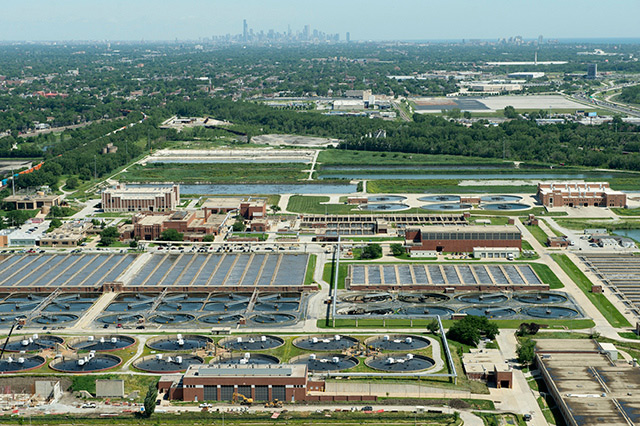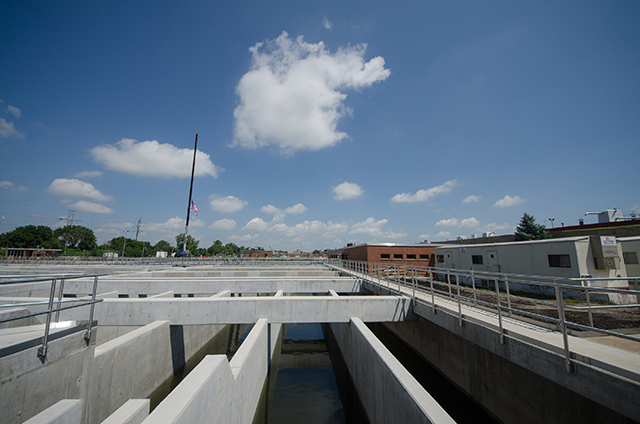
The Calumet Water Reclamation Plant (CWRP) on the Far South Side of Chicago is the oldest of the seven MWRD water treatment facilities. In operation since 1922, it serves residents and businesses in the southern portion of Cook County. At the time of its opening, the 16-mile Calumet-Sag Channel had just become operational. By 1928, CWRP served a population of 155,000. At present, CWRP's service population is more than 1 million people in an area of about 300 square miles.
CWRP provides primary, secondary and tertiary treatment, to remove contaminants during a series of treatment processes, including screening, filtering, settling and microbial aeration. The final phase of water treatment processes at CWRP is disinfection via chlorination/de-chlorination. The disinfection facility, which opened in 2015, neutralizes or kills bacteria and microorganisms in treated water and reduces the risk of health problems resulting from direct contact with the water while recreating on a waterway. Engineers modified the existing chlorine contact basin by replacing all interior baffle walls and associated walkways; replacing weir gates, discharge gates, drain sluice gates, inlet sluice gates and a bypass sluice gate; replacing liquid sodium hypochlorite diffuser piping; installing liquid sodium bisulfite diffuser piping; and installing sampling pumps. To read more about the opening of the new facility, visit here.
CWRP receives the flow from the Calumet Tunnel System and the Thornton Reservoir, both major parts of the Tunnel and Reservoir Plan (TARP), which helps to reduce flooding and control pollution by eliminating combined sewer over-flows. Clean water that has passed through the Calumet WRP treatment processes is then released into the Little Calumet River. It only takes about eight hours for wastewater to be converted from raw sewage to clean water.
Building upon the MWRD’s resource recovery model, CWRP will soon be home to an organics receiving station and a biogas cleaning utilization facility to meet the agency’s pursuit of energy neutrality. Biogas, generated as a byproduct of the anaerobic digestion process at CWRP, has value as a fuel. Currently, the biogas is used to produce steam in boilers for plant heating. However, there are periods of time in the year when the steam demand is low and not all of the biogas is fully utilized. This project will increase biogas production by approximately 160 percent over the current volume by utilizing excess capacity in the digesters to take in organic waste material from outside sources. All of the biogas produced by plant solids and organic feedstock will then be fully utilized as an energy source, as a step towards energy neutrality. Construction includes a receiving pit for slurries from pre-processed wet commercial waste, storage tanks for higher strength liquid waste and fats, oils and greases, screens, transfer pumps.
When biogas is conditioned and upgraded to a
pipeline-quality, renewable, natural gas product, it becomes
"biomethane." MWRD staff and engineers are developing a plan to
clean digester gas from the plant’s anaerobic digesters to produce
biomethane. The project consists of connecting to the plant’s
digester gas collection piping system, installing a pressure swing
absorption gas cleaning system in the vicinity of the anaerobic
digester complex, installing gas compressors and a gas pipeline, and
connecting to a natural gas pipeline located near the Calumet WRP.
The resulting biomethane can be sold to the natural gas pipeline,
where it will be used for vehicle fuel. Although the biomethane will
not be directly used on-site, by adding it to the natural gas
pipeline, it off-sets the need for an equivalent volume of
petroleum-based natural gas and represents the MWRD's contribution
towards the production of renewable energy. The project will reduce
greenhouse gas emissions by an estimated 9,000 metric tons of carbon
dioxide equivalent per year.
To learn more about Calumet WRP,
visit
here.

The Calumet Water Reclamation Plant's disinfection contact basin will provide another layer of protection by disinfecting treated water through a chlorination/dechlorination process.
| National Association of Clean Water Agencies | |
2018 |
Platinum Award for 100% Compliance with National Pollutant Discharge Elimination System Effluent Standards. |
|
2017 |
Platinum Award for 100% Compliance with National Pollutant Discharge Elimination System Effluent Standards. |
2016 |
Platinum Award for 100% Compliance with National Pollutant Discharge Elimination System Effluent Standards. |
|
2015 |
Platinum Award for 100% Compliance with National Pollutant Discharge Elimination System Effluent Standards. |
|
2014 |
Platinum Award for 100% Compliance with National Pollutant Discharge Elimination System Effluent Standards. |
|
2013 |
Platinum Award for 100% Compliance with National Pollutant Discharge Elimination System Effluent Standards. |
|
2012 |
Platinum Award for 100% Compliance with National Pollutant Discharge Elimination System Effluent Standards. |
|
2011 |
Platinum Award for 100% Compliance with National Pollutant Discharge Elimination System Effluent Standards. |
|
2010 |
Platinum Award for 100% Compliance with National Pollutant Discharge Elimination System Effluent Standards. |
|
2009 |
Platinum Award for 100% Compliance with National Pollutant Discharge Elimination System Effluent Standards. |
|
2008 |
Platinum Award for 100% Compliance with National Pollutant Discharge Elimination System Effluent Standards. |
|
2007 |
Platinum Award for 100% Compliance with National Pollutant Discharge Elimination System Effluent Standards. |
|
1993 |
Outstanding Operations Award for Sidestream Pool Aeration Stations. |